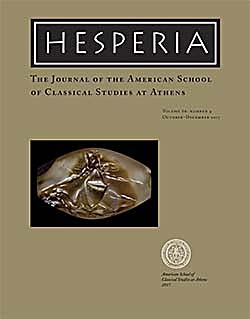Hesperia 86.4 Now Online!

The American School of Classical Studies at Athens is pleased to announce the publication of Hesperia 86.4. Topics in this issue include the presentation of a recently discovered Late Minoan I sealstone from Pylos that bears a highly detailed combat scene; a look at how Solon’s abolishment of debt in Archaic Athens shows signs of influence by earlier Near Eastern practices; the publication of a previously unpublished votive deposit uncovered near the Sanctuary of Zeus at Nemea in 1925; and a look at how the work of Georg von Peschke, a celebrated artist employed by ASCSA excavations at Corinth, can be placed within the contexts of the Greek avant-garde and the creative identity of the School in the first half of the 20th century.
Subscribers can read the issue online at JSTOR, which now hosts all current issues of Hesperia as well as an archive of past volumes.
The Combat Agate from the Grave of the Griffin Warrior at Pylos, by Sharon R. Stocker and Jack L. Davis, presents a stunning engraved sealstone discovered during the 2015 excavation of the grave of the Griffin Warrior near the Palace of Nestor at Pylos. While the scene of a warrior dispatching two opponents has many known artistic parallels, it is the high degree of detail given to the human forms, weaponry, and clothing that makes this piece a welcome addition to the Aegean iconographic corpus. Based on their analysis, the authors posit that the sealstone was manufactured on Crete in the Late Minoan I period.
Debt and Its Aftermath: The Near Eastern Background to Solon’s Seisachtheia, by Josine Blok and Julia Krul, looks at the unique measure taken by Solon in Archaic-period Athens to cancel all debts, abolish debt slavery, and bring back those individuals who had been sold abroad. The similarities in his poems about his legal reforms show that for this innovation, he drew on the tradition of periodic debt remission and liberation of debt slaves by royal decree in the empires of ancient Mesopotamia, about which he may have heard during his travels in the Near East.
The Rawson Deposit: Evidence of an Archaic Spring Shrine near the Sanctuary of Zeus at Nemea, by Signe Barfoed, examines an Archaic-period votive deposit from Nemea that was found to comprise Corinthian miniature pottery as well as other Argive, Attic, and local wares. The assemblage from this deposit, studied first, and most extensively, by Marion Rawson in the 1930s, is today incomplete after it was moved from one location to another due to World War II. This article examines the history of the deposit through the study of the extant material and the original excavation notebook, photographs, and watercolor paintings to present a complete overview of the material. The author catalogues a representative selection of finds, and through their analysis, she suggests that the deposit belonged to a rural spring shrine devoted to Demeter and Kore, perhaps the Adrasteia Spring mentioned by Pausanias, that provided water for the Sanctuary of Zeus in the 6th century.
Flights of Archaeology: Peschke’s Acrocorinth, by Kostis Kourelis, looks at the life and work of Georg Vinko von Peschke, a celebrated artist in 1930s Greece and a staff member of the American School excavations in Corinth, Isthmia, and Olynthos. His painting Acrocorinth (1932), created while carrying out the castle’s architectural survey, provides insights into the creative dimensions behind the School’s scholarly identity. Peschke brought archaeological practices into a direct conversation with Greek modernist poetics that sought to incorporate old historical landscapes with new and radical conceptions of the self.